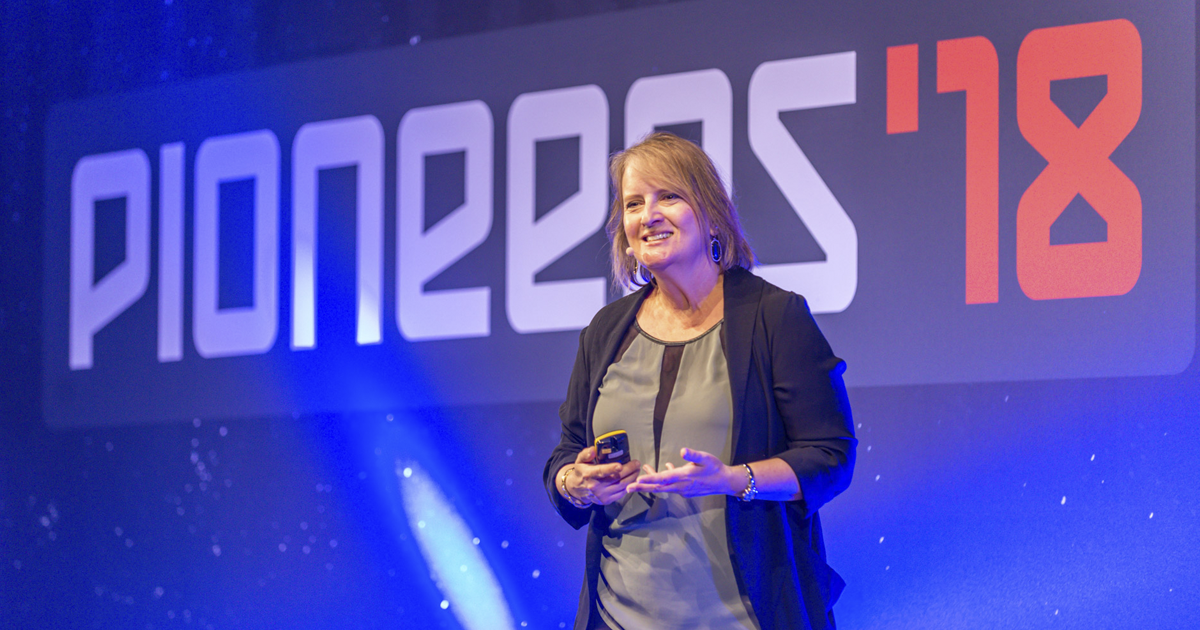
Unless your startup idea is so obviously brilliant that customers and investors are knocking at your door without invitation, chances are you’re going to need to weave a compelling story and master the art of pitching if you want to meet with success. And with events like Pioneers’18 typically offering a tight three minutes in which to sell your concept on stage, it’s imperative to get it spot-on.
Patti Sanchez, who flew to Vienna from California to share her insights in the Leaders Illuminate the Path session at our flagship event at the end of May, says that the most essential ingredient to resonating with your audience is to hone in on the pain your startup is going to save. And, says the co-author of Illuminate: Ignite Change Through Speeches, Stories, Ceremonies & Symbols, replacing peripheral details with anecdote is something a lot more founders could think about doing.
“Be clear on your ‘big idea’,” she advises. “Many founders have a grand vision but have a hard time boiling it down and stating it succinctly. The big idea is a sentence that articulates a problem, your point of view on that problem, and the stakes of solving that problem.
“Why is this problem worth solving, and how are you uniquely able to solve it? If you can sum that up in a sentence, you can build a presentation structure to support that. This also helps you leave out all the things that aren’t relevant to that ‘big idea’.”
Such details might include team member biographies, too deep a dive into the workings of your technology, vague ‘revolutionary talk’, meaningless buzzwords and sometimes even too much on how the business model is going to work. Making the big idea real and human is much more relevant than any of that.
“Founders get into too much of the weeds,” says Sanchez. “The first thing is always to explain what your promise is. What are you trying to do, why do you exist and how are you going to solve your problem better than anyone else?
“So get really concrete about the people who would potentially buy your product, and how they would use it. There’s a temptation to sell a brand vision – but tell me the three ways in which your service is going to change the lives of your customers in some way! It’s about making the way in which your product will be useful more tangible.”
One way to do this is to use a graphic example. Even in a three-minute pitch, says Sanchez, storytelling in its most literal sense can have more impact than the very best slides in your deck.
“Storytelling can take you through an anecdote of a scenario situation that a real company or person is facing. The classic three-act story structure fits perfectly there: the likeable hero facing a challenge at the beginning, then encountering a mentor or helper who helps them overcome these challenges, and in the end they are transformed. In the context of your startup those elements are customers, challenge and resolution.
“If you only have three minutes then for sure you only have time for one such anecdote. But it’s a great way to make your promise very concrete.”
One way to make it thoroughly vague, on the other hand, can be the unthinking use of buzzword terms like Blockchain, Artificial Intelligence and Machine Learning. Shouldn’t startups be careful when considering whether to throw them around in their pitches?
“Yes, I think that’s good advice,” says Sanchez. “People and companies are jumping on the bandwagon, and saying they’re using things like AI when maybe they’re not. Or they’re using the buzzword without explaining why it’s necessary for their solution. It’s always a mistake to use a buzzword instead of a benefit.”
Finally, says Sanchez, you cannot expect to pitch successfully without considering exactly whom you’re pitching to.
“Know your audience and what really matters to them. What types of investments do they usually fund? What are the requirements or capabilities of companies they fund? Know them and tailor your talk to them.
“It’s a mistake that a lot of founders make to tell the same story to everyone all the time. A quick way to lose your audience is if they don’t see themselves in it. So have the short few slides summary of who you are, what you do and why that’s a problem you’re solving, but then go into modules – how your solution applies to this or that market segment. Those become slides that you swap in and out depending on who you are talking to.”
When you’ve sat through enough pitches that still leave you bemused on the most fundamental questions about what a startup does, Sanchez’s advice makes a lot of sense. While it can arguably be tough to illustrate ‘the big idea’ on an engaging level for some startups in less ‘sexy’ technology, there are still powerful ways and means of doing so. For more on this, the profound impact of physical interactions at events and learning from the Hyperloop One’s storytelling strategy, stay tuned to our channels for part two of this interview!
Read the story of our Pioneers’17 winning startup Stromkind travelling to Silicon Valley and taking part in a communications workshop with Duarte here.
